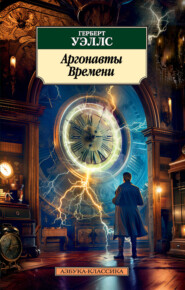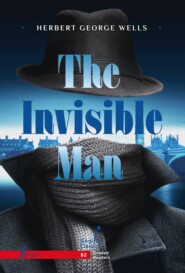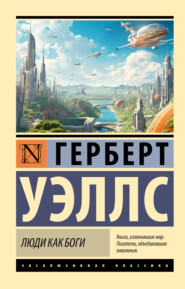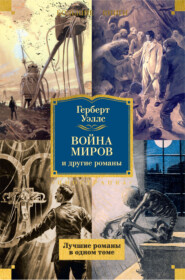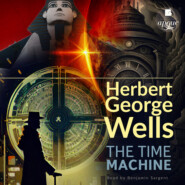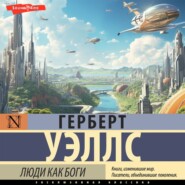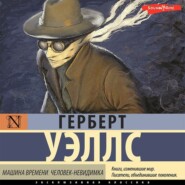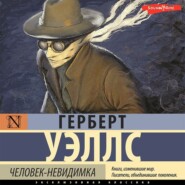По всем вопросам обращайтесь на: info@litportal.ru
(©) 2003-2024.
✖
The Country of the Blind, and Other Stories
Настройки чтения
Размер шрифта
Высота строк
Поля
The messenger, sent in furious haste from the station to find out what had happened in the dynamo shed, met Azuma-zi at the porter's lodge by the gate. Azuma-zi tried to explain something, but the messenger could make nothing of the black's incoherent English, and hurried on to the shed. The machines were all noisily at work, and nothing seemed to be disarranged. There was, however, a queer smell of singed hair. Then he saw an odd-looking crumpled mass clinging to the front of the big dynamo, and, approaching, recognised the distorted remains of Holroyd.
The man stared and hesitated a moment. Then he saw the face, and shut his eyes convulsively. He turned on his heel before he opened them, so that he should not see Holroyd again, and went out of the shed to get advice and help.
When Azuma-zi saw Holroyd die in the grip of the Great Dynamo he had been a little scared about the consequences of his act. Yet he felt strangely elated, and knew that the favour of the Lord Dynamo was upon him. His plan was already settled when he met the man coming from the station, and the scientific manager who speedily arrived on the scene jumped at the obvious conclusion of suicide. This expert scarcely noticed Azuma-zi, except to ask a few questions. Did he see Holroyd kill himself? Azuma-zi explained he had been out of sight at the engine furnace until he heard a difference in the noise from the dynamo. It was not a difficult examination, being untinctured by suspicion.
The distorted remains of Holroyd, which the electrician removed from the machine, were hastily covered by the porter with a coffee-stained table-cloth. Somebody, by a happy inspiration, fetched a medical man. The expert was chiefly anxious to get the machine at work again, for seven or eight trains had stopped midway in the stuffy tunnels of the electric railway. Azuma-zi, answering or misunderstanding the questions of the people who had by authority or impudence come into the shed, was presently sent back to the stoke-hole by the scientific manager. Of course a crowd collected outside the gates of the yard – a crowd, for no known reason, always hovers for a day or two near the scene of a sudden death in London – two or three reporters percolated somehow into the engine-shed, and one even got to Azuma-zi; but the scientific expert cleared them out again, being himself an amateur journalist.
Presently the body was carried away, and public interest departed with it. Azuma-zi remained very quietly at his furnace, seeing over and over again in the coals a figure that wriggled violently and became still. An hour after the murder, to any one coming into the shed it would have looked exactly as if nothing remarkable had ever happened there. Peeping presently from his engine-room the black saw the Lord Dynamo spin and whirl beside his little brothers, and the driving wheels were beating round, and the steam in the pistons went thud, thud, exactly as it had been earlier in the evening. After all, from the mechanical point of view, it had been a most insignificant incident – the mere temporary deflection of a current. But now the slender form and slender shadow of the scientific manager replaced the sturdy outline of Holroyd travelling up and down the lane of light upon the vibrating floor under the straps between the engines and the dynamos.
"Have I not served my Lord?" said Azuma-zi inaudibly, from his shadow, and the note of the great dynamo rang out full and clear. As he looked at the big whirling mechanism the strange fascination of it that had been a little in abeyance since Holroyd's death resumed its sway.
Never had Azuma-zi seen a man killed so swiftly and pitilessly. The big humming machine had slain its victim without wavering for a second from its steady beating. It was indeed a mighty god.
The unconscious scientific manager stood with his back to him, scribbling on a piece of paper. His shadow lay at the foot of the monster.
Was the Lord Dynamo still hungry? His servant was ready.
Azuma-zi made a stealthy step forward; then stopped. The scientific manager suddenly ceased his writing, walked down the shed to the endmost of the dynamos, and began to examine the brushes.
Azuma-zi hesitated, and then slipped across noiselessly into the shadow by the switch. There he waited. Presently the manager's footsteps could be heard returning. He stopped in his old position, unconscious of the stoker crouching ten feet away from him. Then the big dynamo suddenly fizzled, and in another moment Azuma-zi had sprung out of the darkness upon him.
First, the scientific manager was gripped round the body and swung towards the big dynamo, then, kicking with his knee and forcing his antagonist's head down with his hands, he loosened the grip on his waist and swung round away from the machine. Then the black grasped him again, putting a curly head against his chest, and they swayed and panted as it seemed for an age or so. Then the scientific manager was impelled to catch a black ear in his teeth and bite furiously. The black yelled hideously.
They rolled over on the floor, and the black, who had apparently slipped from the vice of the teeth or parted with some ear – the scientific manager wondered which at the time – tried to throttle him. The scientific manager was making some ineffectual efforts to claw something with his hands and to kick, when the welcome sound of quick footsteps sounded on the floor. The next moment Azuma-zi had left him and darted towards the big dynamo. There was a splutter amid the roar.
The officer of the company who had entered stood staring as Azuma-zi caught the naked terminals in his hands, gave one horrible convulsion, and then hung motionless from the machine, his face violently distorted.
"I'm jolly glad you came in when you did," said the scientific manager, still sitting on the floor.
He looked at the still quivering figure. "It is not a nice death to die, apparently – but it is quick."
The official was still staring at the body. He was a man of slow apprehension.
There was a pause.
The scientific manager got up on his feet rather awkwardly. He ran his fingers along his collar thoughtfully, and moved his head to and fro several times.
"Poor Holroyd! I see now." Then almost mechanically he went towards the switch in the shadow and turned the current into the railway circuit again. As he did so the singed body loosened its grip upon the machine and fell forward on its face. The core of the dynamo roared out loud and clear, and the armature beat the air.
So ended prematurely the worship of the Dynamo Deity, perhaps the most short-lived of all religions. Yet withal it could at least boast a Martyrdom and a Human Sacrifice.
IX.
THE MOTH
Probably you have heard of Hapley – not W. T. Hapley, the son, but the celebrated Hapley, the Hapley of Periplaneta Hapliia, Hapley the entomologist.
If so you know at least of the great feud between Hapley and Professor Pawkins, though certain of its consequences may be new to you. For those who have not, a word or two of explanation is necessary, which the idle reader may go over with a glancing eye, if his indolence so incline him.
It is amazing how very widely diffused is the ignorance of such really important matters as this Hapley-Pawkins feud. Those epoch-making controversies, again, that have convulsed the Geological Society are, I verily believe, almost entirely unknown outside the fellowship of that body. I have heard men of fair general education even refer to the great scenes at these meetings as vestry-meeting squabbles. Yet the great hate of the English and Scotch geologists has lasted now half a century, and has "left deep and abundant marks upon the body of the science." And this Hapley-Pawkins business, though perhaps a more personal affair, stirred passions as profound, if not profounder. Your common man has no conception of the zeal that animates a scientific investigator, the fury of contradiction you can arouse in him. It is the odium theologicum in a new form. There are men, for instance, who would gladly burn Professor Ray Lankester at Smithfield for his treatment of the Mollusca in the Encyclopaedia. That fantastic extension of the Cephalopods to cover the Pteropods … But I wander from Hapley and Pawkins.
It began years and years ago, with a revision of the Microlepidoptera (whatever these may be) by Pawkins, in which he extinguished a new species created by Hapley. Hapley, who was always quarrelsome, replied by a stinging impeachment of the entire classification of Pawkins.[2 - "Remarks on a Recent Revision of Microlepidoptera." Quart. Journ. Entomological Soc., 1863.] Pawkins in his "Rejoinder"[3 - "Rejoinder to certain Remarks," etc. Ibid. 1864.] suggested that Hapley's microscope was as defective as his power of observation, and called him an "irresponsible meddler" – Hapley was not a professor at that time. Hapley in his retort,[4 - "Further Remarks," etc. Ibid.] spoke of "blundering collectors," and described, as if inadvertently, Pawkins' revision as a "miracle of ineptitude." It was war to the knife. However, it would scarcely interest the reader to detail how these two great men quarrelled, and how the split between them widened until from the Microlepidoptera they were at war upon every open question in entomology. There were memorable occasions. At times the Royal Entomological Society meetings resembled nothing so much as the Chamber of Deputies. On the whole, I fancy Pawkins was nearer the truth than Hapley. But Hapley was skilful with his rhetoric, had a turn for ridicule rare in a scientific man, was endowed with vast energy, and had a fine sense of injury in the matter of the extinguished species; while Pawkins was a man of dull presence, prosy of speech, in shape not unlike a water-barrel, over conscientious with testimonials, and suspected of jobbing museum appointments. So the young men gathered round Hapley and applauded him. It was a long struggle, vicious from the beginning and growing at last to pitiless antagonism. The successive turns of fortune, now an advantage to one side and now to another – now Hapley tormented by some success of Pawkins, and now Pawkins outshone by Hapley, belong rather to the history of entomology than to this story.
But in 1891 Pawkins, whose health had been bad for some time, published some work upon the "mesoblast" of the Death's Head Moth. What the mesoblast of the Death's Head Moth may be does not matter a rap in this story. But the work was far below his usual standard, and gave Hapley an opening he had coveted for years. He must have worked night and day to make the most of his advantage.
In an elaborate critique he rent Pawkins to tatters – one can fancy the man's disordered black hair, and his queer dark eyes flashing as he went for his antagonist – and Pawkins made a reply, halting, ineffectual, with painful gaps of silence, and yet malignant. There was no mistaking his will to wound Hapley, nor his incapacity to do it. But few of those who heard him – I was absent from that meeting – realised how ill the man was.
Hapley got his opponent down, and meant to finish him. He followed with a simply brutal attack upon Pawkins, in the form of a paper upon the development of moths in general, a paper showing evidence of a most extraordinary amount of mental labour, and yet couched in a violently controversial tone. Violent as it was, an editorial note witnesses that it was modified. It must have covered Pawkins with shame and confusion of face. It left no loophole; it was murderous in argument, and utterly contemptuous in tone; an awful thing for the declining years of a man's career.
The world of entomologists waited breathlessly for the rejoinder from Pawkins. He would try one, for Pawkins had always been game. But when it came it surprised them. For the rejoinder of Pawkins was to catch influenza, proceed to pneumonia, and die.
It was perhaps as effectual a reply as he could make under the circumstances, and largely turned the current of feeling against Hapley. The very people who had most gleefully cheered on those gladiators became serious at the consequence. There could be no reasonable doubt the fret of the defeat had contributed to the death of Pawkins. There was a limit even to scientific controversy, said serious people. Another crushing attack was already in the press and appeared on the day before the funeral. I don't think Hapley exerted himself to stop it. People remembered how Hapley had hounded down his rival, and forgot that rival's defects. Scathing satire reads ill over fresh mould. The thing provoked comment in the daily papers. This it was that made me think that you had probably heard of Hapley and this controversy. But, as I have already remarked, scientific workers live very much in a world of their own; half the people, I dare say, who go along Piccadilly to the Academy every year, could not tell you where the learned societies abide. Many even think that research is a kind of happy-family cage in which all kinds of men lie down together in peace.
In his private thoughts Hapley could not forgive Pawkins for dying. In the first place, it was a mean dodge to escape the absolute pulverisation Hapley had in hand for him, and in the second, it left Hapley's mind with a queer gap in it. For twenty years he had worked hard, sometimes far into the night, and seven days a week, with microscope, scalpel, collecting-net, and pen, and almost entirely with reference to Pawkins. The European reputation he had won had come as an incident in that great antipathy. He had gradually worked up to a climax in this last controversy. It had killed Pawkins, but it had also thrown Hapley out of gear, so to speak, and his doctor advised him to give up work for a time, and rest. So Hapley went down into a quiet village in Kent, and thought day and night of Pawkins, and good things it was now impossible to say about him.
At last Hapley began to realise in what direction the pre-occupation tended. He determined to make a fight for it, and started by trying to read novels. But he could not get his mind off Pawkins, white in the face and making his last speech – every sentence a beautiful opening for Hapley. He turned to fiction – and found it had no grip on him. He read the "Island Nights' Entertainments" until his "sense of causation" was shocked beyond endurance by the Bottle Imp. Then he went to Kipling, and found he "proved nothing," besides being irreverent and vulgar. These scientific people have their limitations. Then unhappily, he tried Besant's "Inner House," and the opening chapter set his mind upon learned societies and Pawkins at once.
So Hapley turned to chess, and found it a little more soothing. He soon mastered the moves and the chief gambits and commoner closing positions, and began to beat the Vicar. But then the cylindrical contours of the opposite king began to resemble Pawkins standing up and gasping ineffectually against check-mate, and Hapley decided to give up chess.
Perhaps the study of some new branch of science would after all be better diversion. The best rest is change of occupation. Hapley determined to plunge at diatoms, and had one of his smaller microscopes and Halibut's monograph sent down from London. He thought that perhaps if he could get up a vigorous quarrel with Halibut, he might be able to begin life afresh and forget Pawkins. And very soon he was hard at work in his habitual strenuous fashion, at these microscopic denizens of the way-side pool.
It was on the third day of the diatoms that Hapley became aware of a novel addition to the local fauna. He was working late at the microscope, and the only light in the room was the brilliant little lamp with the special form of green shade. Like all experienced microscopists, he kept both eyes open. It is the only way to avoid excessive fatigue. One eye was over the instrument, and bright and distinct before that was the circular field of the microscope, across which a brown diatom was slowly moving. With the other eye Hapley saw, as it were, without seeing. He was only dimly conscious of the brass side of the instrument, the illuminated part of the table-cloth, a sheet of notepaper, the foot of the lamp, and the darkened room beyond.
Suddenly his attention drifted from one eye to the other. The table-cloth was of the material called tapestry by shopmen, and rather brightly coloured. The pattern was in gold, with a small amount of crimson and pale blue upon a greyish ground. At one point the pattern seemed displaced, and there was a vibrating movement of the colours at this point.
Hapley suddenly moved his head back and looked with both eyes. His mouth fell open with astonishment.
It was a large moth or butterfly; its wings spread in butterfly fashion!
It was strange it should be in the room at all, for the windows were closed. Strange that it should not have attracted his attention when fluttering to its present position. Strange that it should match the table-cloth. Stranger far that to him, Hapley, the great entomologist, it was altogether unknown. There was no delusion. It was crawling slowly towards the foot of the lamp.
"New Genus, by heavens! And in England!" said Hapley, staring.
Then he suddenly thought of Pawkins. Nothing would have maddened Pawkins more…And Pawkins was dead!
Something about the head and body of the insect became singularly suggestive of Pawkins, just as the chess king had been.
"Confound Pawkins!" said Hapley. "But I must catch this." And looking round him for some means of capturing the moth, he rose slowly out of his chair. Suddenly the insect rose, struck the edge of the lampshade – Hapley heard the "ping" – and vanished into the shadow.
In a moment Hapley had whipped off the shade, so that the whole room was illuminated. The thing had disappeared, but soon his practised eye detected it upon the wall-paper near the door. He went towards it poising the lamp-shade for capture. Before he was within striking distance, however, it had risen and was fluttering round the room. After the fashion of its kind, it flew with sudden starts and turns, seeming to vanish here and reappear there. Once Hapley struck, and missed; then again.
The third time he hit his microscope. The instrument swayed, struck and overturned the lamp, and fell noisily upon the floor. The lamp turned over on the table and, very luckily, went out. Hapley was left in the dark. With a start he felt the strange moth blunder into his face.
It was maddening. He had no lights. If he opened the door of the room the thing would get away. In the darkness he saw Pawkins quite distinctly laughing at him. Pawkins had ever an oily laugh. He swore furiously and stamped his foot on the floor.
There was a timid rapping at the door.
Then it opened, perhaps a foot, and very slowly. The alarmed face of the landlady appeared behind a pink candle flame; she wore a night-cap over her grey hair and had some purple garment over her shoulders. "What was that fearful smash?" she said. "Has anything – " The strange moth appeared fluttering about the chink of the door. "Shut that door!" said Hapley, and suddenly rushed at her.






